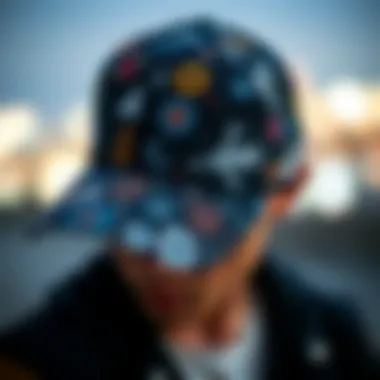Trendy Men's Hats: Styles, Trends, and Care Tips


Intro
Welcome to the captivating realm of trendy men’s hats, where every stitch and style tells a story. In recent years, hats have transitioned from mere functional accessories to compelling fashion statements. This evolution reflects not only personal style but also broader cultural movements, making hats a focal point in men's wardrobes today. So, whether you're hunting for a classic fedora to don for a night out or a cozy beanie to keep warm during chilly months, understanding the various styles and their origins can really elevate your fashion game.
Gone are the days when hats were merely a safeguard against the elements; now, they are a canvas of self-expression. From the street to the runway, hats encapsulate a blend of heritage, innovation, and style that resonates with a wide range of personalities and aesthetics. Let’s embark on this exploration to unveil the dynamics of men’s headwear in our modern fashion landscape.
Foreword to Trendy Men's Hats
In the realm of fashion, men’s hats have always occupied a distinct niche, serving not just as functional accessories but also as pivotal components in crafting a style narrative. Understanding the dynamics of trendy men’s hats today is not merely about picking a fashionable item off the rack; it's about recognizing how history and culture influence our choices. This article dives deep into the multifaceted world of men’s headwear, exploring styles, cultural implications, and the nuanced art of selection and care.
The Evolution of Men's Headwear
The history of men’s headwear is rich and varied, reflecting societal transformations, trends, and the evolving definitions of masculinity. From the top hats of the Victorian era to the more laid-back beanie styles of today, each type of hat has its own story that intertwines with historical milestones.
For instance, during the early 20th century, the fedora was worn by iconic figures like Humphrey Bogart, gaining fame as a symbol of coolness and ease. As society progressed, the baseball cap emerged, marrying practicality with leisure, further embedding itself into popular culture through sports and, eventually, streetwear.
Hats were not just accessories; they were statements, reflecting the culture of their time. Understanding this evolution helps fashion enthusiasts appreciate the complexities behind choosing the right hat. Familiarizing oneself with this timeline offers a broader perspective, illustrating how past styles influence modern trends.
Significance of Hats in Contemporary Fashion
In today’s fashion landscape, hats have comfortably transitioned from mere protection against the elements to a vital aspect of expression and identity. Popular culture, especially within music and film, plays a significant role in dictating hat trends. Icons like Pharrell Williams with his oversized Vivienne Westwood hat or Brad Pitt’s trilby continually spark conversations rife with cultural significance.
But why do hats matter in contemporary style? Firstly, they are versatile. A well-chosen hat can elevate a casual outfit or ground a more sophisticated look, offering depth and craftsmanship that other accessories might lack. Hats also present a sense of individuality; in a sea of similar styles, the right hat allows a person to stand out.
Furthermore, hats are deeply intertwined with personal identity—whether worn as a nod to one’s heritage, profession, or simply as a fashion statement, they convey untold stories through fabric and form.
"A hat can be a conversation starter, a statement piece, or simply an expression of personal style."
In summary, hats are much more than a trend; they are carriers of culture and individuality, shaping how men express themselves in a world increasingly characterized by conformity and sameness.
Popular Types of Men's Hats
In the ever-evolving world of fashion, hats hold a distinctive position. They not only serve as an accessory but also play a functional role, offering protection from the elements while completing an ensemble. Understanding the popular types of men's hats is paramount for anyone looking to elevate their style game. Each type of hat carries its unique history, purpose, and charm, making it a key element in the wardrobe of any style-savvy man.
Fedoras and Their Timeless Appeal
The fedora, often regarded as a symbol of sophistication and class, has transcended generations. Originally designed for women in the late 19th century, this stylish hat was later adopted by men, becoming a staple in their fashion repertoire. Typical features include a soft brim and an indented crown, which can be worn with a variety of outfits.
Worn by iconic figures throughout the decades—from gangsters in black-and-white films to contemporary fashion icons—fedoras invoke a certain je ne sais quoi. They can be styled casually or added to formal attire, seamlessly transitioning between both realms. When choosing a fedora, consider its material; felt for colder weather or straw for sun-soaked days can make all the difference in comfort and appearance.
A well-chosen fedora can transform the mundane into the extraordinary, making the wearer stand out without saying a word.
Beanies: A Blend of Comfort and Style
Beanies are often seen as the quintessential casual hat, embodying comfort and versatility. Commonly made from knit materials, they hug the head snugly and often feature a rolled brim or a slouchy design.
They're perfect companions for chilly days, combining warmth with a laid-back aesthetic. But they aren’t just for winter; beanies have made their way into summer festivals and street style, serving as a canvas for personal expression. There are countless colors, patterns, and materials available, allowing for an individual touch in any outfit. Pairing a beanie with a well-fitted jacket or a graphic tee can create a visually appealing look that speaks volumes.
Baseball Caps: The Casual Staple
The baseball cap is perhaps the most ubiquitous of men's headwear. First worn by baseball players, these caps have remarkably morphed into everyday essentials, transcending their initial sporting roots. They provide a casual vibe and were once reserved for informal outings, but they have now advanced into high fashion.
Features include a stiff brim and an adjustable band, often adorned with logos or distinct designs. Wearing a baseball cap can easily convey your personality and interests, with options ranging from unassuming to bold. Whether shielding your eyes from the sun or simply topping off your look, baseball caps are an understated yet impactful statement piece.
Flat Caps: Heritage Meets Modernity


Flat caps, often associated with British culture, seamlessly blend heritage with contemporary style. These hats have deep roots in working-class history, yet they have emerged as a fashionable choice for many men across the globe. The structured yet relaxed style consists of a rounded crown and a small, stiff brim.
They can be made from varied materials such as tweed, cotton, and linen, making them versatile for different seasons. While they exude an air of nostalgia, flat caps can be paired with modern outfits, from tailored suits to casual wear, giving a nod to history while remaining fresh.
Bucket Hats: A Functional Fashion Statement
The bucket hat has seen a huge resurgence in popularity, once relegated to fishermen and outdoor enthusiasts. Today, it represents a playful and functional accessory in men's fashion. Characterized by its wide, downward-sloping brim, the bucket hat shields wearers from the sun and rain, making it practical for various conditions.
What sets bucket hats apart is the variety of styles they come in—from colorful prints to sleek, monochromatic designs. They can easily add a relaxed vibe to both streetwear and beach attire, proving that functionality can come with a sense of style. The key here is to choose a bucket hat that complements your overall look, allowing it to shine without overshadowing your outfit.
Understanding these different types of men's hats is crucial for anyone aiming to enhance their personal style. Each hat type brings something unique to the table and can be paired differently, depending on the occasion and aesthetic desired. From the sharp fedora to the casual baseball cap, there’s no shortage of options to express yourself through headwear.
Cultural Influences on Hat Trends
When it comes to understanding the world of trendy men's hats, one cannot overlook the profound impact of cultural influences. Hats, beyond their functional purpose, serve as powerful symbols that weave together threads of identity, history, and social commentary. In this section, we will dive into two key areas that showcase the complexity of hat trends: the role of music and pop culture and regional styles and their significance.
The Role of Music and Pop Culture
Music has always played a pivotal role in shaping fashion trends, and hats are no exception. Icons like Frank Sinatra with his fedora or even hip-hop legends who sport bucket hats have left indelible marks on hat styles through the ages. The influence doesn't just stop at the legends—current trends often emerge from the vibrant worlds of music festivals and street style.
For instance, look at how the beanie found a home in the skate and punk scenes. These genres have adopted hats not only as an accessory but as a statement of rebellion and individuality. The rise of online platforms like TikTok and Instagram allows artists to set trends in real-time. A simple post of a musician wearing a distinctive hat can spark a wave of imitators, sending the popularity of that style soaring.
"> "Fashion is about dressing according to what's fashionable. Style is more about being yourself." - Oscar de la Renta
In addition, music videos serve as a catwalk for expression. From the vibrant patterns and styles of African headgear showcased by artists of various backgrounds to the classic simplicity in rock music videos, there’s a vast array of influences at play. These cultural intersections contribute to the fluidity and innovation of men’s headwear today. Hats are often seen as extensions of oneself, and their cultural significance can shift with every beat.
Regional Styles and Their Significance
Hats also tell stories about geographical and cultural roots. Across the globe, different styles emerge, each steeped in tradition and meaning. Understanding these regional nuances can elevate one’s style immensely.
- The Akubra from Australia embodies ruggedness, suited to the outback lifestyle.
- The African Kufi symbolizes dignity and is often worn during religious events.
- Pork pie hats seen in British subcultures emanate sophistication and a hint of mischief.
- In North America, the cowboy hat speaks to a heritage of adventure, freedom, and hard work.
These styles don't just represent geographical origins; they also encapsulate cultural narratives. The fez, once a symbol of Ottoman Empire authority, finds new meaning in contemporary fashion as it reappears in urban settings, becoming a bold statement piece.
When one wears a hat that is rooted in cultural significance, it’s not merely a fashion choice; it’s akin to carrying history on one’s head. This interplay between culture and fashion enriches the wearer’s personal narrative, allowing for a deeper connection with their attire.
In summary, cultural influences on hat trends are multifaceted, weaving together music, history, and regional styles into a rich tapestry. This understanding not only helps in selecting the right hat but also enhances the overall sartorial experience by embracing the stories and traditions that accompany these headpieces.
Choosing the Right Hat for Your Style
Choosing the right hat for your style is more than just a fashion statement; it becomes an extension of your personality and a reflection of your individuality. This segment is particularly important, as a hat holds the power to elevate an outfit while also serving practical functions, such as protecting one from the sun or adding warmth in colder climates. Getting it right can mean the difference between feeling utterly put together or being seen as a mismatched mess.
A well-selected hat can showcase a keen sense of fashion, and when paired appropriately with your wardrobe, it contributes to an overall polished appearance. By understanding your style and the various hats available, you can enhance your look while enjoying the comfort and style that comes with wearing the right headwear.
Understanding Face Shapes
When it comes to selecting a hat, understanding your face shape is crucial. Different hat styles complement various shapes, and knowing yours can significantly enhance your overall look. Here are a few common face shapes and the corresponding hat styles that typically suit them:
- Oval: Most styles work well, but wide-brimmed hats can balance the proportions beautifully.
- Square: Opt for rounded styles like fedoras or beanies to soften angular features.
- Round: A tall crown and wide brim can elongate a round face - consider fedora or a cowboy hat.
- Heart: Hats with wider brims draw attention away from a narrower chin, making options like the floppy hat an ideal choice.
Measuring your face and identifying your shape can guide you in this process. A mirror and a tape measure can go a long way in understanding proportions. Taking this first step ensures that your hat is not only fashionable but enhances your natural features.
Considerations for Outfit Coordination
The interplay between hats and clothes is an essential element for pulling off any look. When considering what to wear, keep these factors in mind:


- Color Matching: A hat shouldn't clash with your outfit. Use complementary colors, or stick with neutrals for versatility.
- Style Harmony: The overall vibe of your clothing should align with your hat. A crisp fedora may not pair well with casual jeans and a T-shirt.
- Occasion Appropriateness: Different events call for different hats. A beanie may be perfect for a laid-back weekend outing, but it might not cut it in a formal gathering.
Combining different elements requires a bit of finesse. Try experimenting with shades, patterns, and textures to see what works best for you. This not only will improve the visual appeal of your outfit but also your confidence.
Seasonal Suggestions for Hat Selection
Seasons affect not just our wardrobe but also our choice of headwear. Each time of the year brings unique necessities and styles:
- Spring: Lightweight materials like straw are perfect for this time of year. Flowing styles like sun hats keep you fashionable while offering sun protection.
- Summer: Breathable fabrics and open-weave designs help in keeping things cool as temperatures rise. Think bucket hats or straw fedoras that invite laid-back vibes.
- Autumn: Transitioning into cooler weather, a knitted beanie or wool flat cap keeps your head warm without compromising style. Layering becomes your best friend this season.
- Winter: A cozy fedora or a well-crafted beanie becomes essential. Materials like cashmere or wool not only provide warmth but also upscale your winter look.
Understanding these seasonal nuances ensures that your hat game is on point all year long. You can easily rotate your collection based on the elements, lending to a practical yet stylish approach to men's headwear.
"Choosing the right hat is akin to selecting the right shoes; it speaks volumes about your overall style."
By taking these considerations into account, you can confidently explore the world of trendy men's hats and find those that not only suit your face shape but coordinate seamlessly with your outfits and the seasons.
The Materials Behind Men's Hats
The materials that go into crafting men's hats play a significant role in determining their style, comfort, and durability. A thorough understanding of these materials can enrich one’s appreciation of headwear and its evolution through trends. Hats are not merely accessories; they serve functional purposes while also activating personal style statements. Whether you're strolling through a sun-drenched park or heading to a winter gathering, the right material can make or break your ensemble.
When selecting a hat, consider not just the visuals, but how different materials interact with your activities. For instance, some fabrics breathe better, while others provide warmth. The choice becomes a dance of aesthetics and utility, catering to both fashion enthusiasts and practical wearers alike.
Traditional Fabrics and Their Uses
Traditionally, hats have been crafted from materials that are natural and accessible, reflecting the environment and culture of their origins. Common fabrics include wool, cotton, and straw, each coming with its own set of benefits:
- Wool: Often used in fedoras and other structured hats, wool provides warmth and has excellent moisture-wicking properties. It tends to hold its shape well, which is essential for hats that require a defined look.
- Cotton: Known for its breathability, cotton is ideal for casual hats like baseball caps and bucket hats. It’s soft, lightweight and comfortable enough for all-day wear.
- Straw: Perfect for summer wear, straw hats like Panama hats offer shade while being lightweight. They evoke a relaxed vibe and are ideal for beach days or outdoor gatherings.
By understanding the connection between the materials and their intended uses, wearers can make choices that suit their lifestyle. For instance, wool hats might be best for winter conditions, whereas a straw hat could serve you well in the sweltering summer sun.
Innovative Materials in Contemporary Designs
As fashion evolves, so do the materials used in crafting men's hats. Innovative fabrics are entering the scene, influenced by both technological advancements and shifting environmental priorities. Here are some noteworthy materials gaining traction:
- Recycled Plastics: Brands are beginning to incorporate recycled materials into their designs, creating hats that not only reduce waste but also appeal to eco-conscious consumers. This trend repurposes waste into fashionable accessories.
- Technical Fibers: Advances in technology have given rise to fabrics that offer enhanced durability and weather resistance. These materials can fend off water, resist fading under sunlight, and maintain breathability. Many sports brands are adopting these fibers for caps intended for rigorous outdoor activities.
- Organic Cotton: With the rising focus on sustainability, organic cotton has made its way into mainstream headwear. It sidesteps harmful pesticides, making it a healthier choice for both consumers and the planet.
"Materials dictate more than the usability of a hat; they shape cultural trends and individual expressions of style."
When considering hats, the material should not be an afterthought. Incorporating both traditional and innovative materials allows for a plethora of styles while addressing contemporary concerns like sustainability. By being aware of what's out there, individuals can choose hats that not only flatter them but align with their values and lifestyle.
In the rapidly changing world of fashion, keeping abreast of materials can give anyone an edge—a blend of aesthetics and informed consumerism.
Sustainable Practices in Hat Production
In an age where sustainability is more than a buzzword, the world of fashion must keep pace with the evolving conscience of consumers. Hat production is no exception. Environmentally responsible practices not only cater to the growing demand for eco-friendly products but also align with a larger global need to protect our environment. Sustainable practices in hat production can significantly impact the fashion industry by reducing carbon footprints, conserving resources, and promoting ethical labor standards.
Sustainability in fashion speaks to the values of modern consumers, many of whom prioritize brands that demonstrate a commitment to environmental stewardship. By integrating sustainable practices into hat production, brands can build stronger relationships with their customers while also ensuring a future for the industry.
Eco-Friendly Materials and Brands
There’s a growing array of eco-friendly materials making their way into hat manufacturing. Organic cotton, for instance, is a favorite choice, offering softness alongside a minimal impact on the soil, as it is grown without synthetic pesticides and fertilizers. Natural dyes, derived from plants and minerals, also contribute to reducing harmful chemical use in production.
Another innovative option comes from recycled materials. Brands like Tilley have successfully created hats made from recycled plastics, turning waste into stylish accessories. Abacaxi, a newer label, uses fabric offcuts, breathing new life into layers of discarded textiles. By choosing brands that focus on eco-friendly materials, consumers can make a statement while promoting sustainable fashion.
When considering eco-friendly brands, look for those transparent about their sourcing methods and production processes. Certifications such as GOTS (Global Organic Textile Standard) or Fair Trade can help guide consumers towards consciously made products.


Reducing Waste in Hat Manufacturing
Waste reduction poses a daunting challenge in the fashion industry, particularly in hat manufacturing, where cutting and shaping materials often generates scraps. However, innovative strategies are emerging to tackle this issue head-on. Many manufacturers are now adopting a zero-waste approach, aiming to utilize every inch of fabric available.
Implementing a "design for disassembly" philosophy can also play a pivotal role in waste reduction. Here, hats are created using materials that are easy to separate for recycling or composting at the end of their life cycle. Some brands, like Fjällräven, have even taken the initiative to offer repair services for their hats, prolonging their lifespan and reducing waste.
Using advanced techniques such as 3D knitting can produce hats with minimal off-cuts. This technology allows for greater precision in material usage, cutting down on waste significantly. Plus, engaging local artisans for production not only cuts down on transportation emissions but ensures that excess materials can be utilized creatively within the community.
"When fashion meets sustainability, it's not just a trend; it's a responsibility. Brands must rethink how they produce and sell to align with modern values."
As the conversation around sustainable practices in hat production continues to grow, so does the opportunity for the fashion industry to reshape its narrative. Engaging consumers, fostering eco-friendly innovations, and reducing waste may very well define the future of men’s hats.
Care and Maintenance of Men's Hats
When it comes to the world of men's fashion, hats often take a back seat. However, proper care and maintenance of these accessories is crucial if one wishes to make a lasting impression. Hats not only add flair to an outfit but also reflect personal style. Keeping them in good condition is essential for longevity and aesthetics. A well-cared-for hat can last years or even generations, allowing you to not only showcase your fashion sense but also to preserve the stories behind them.
Cleaning Techniques for Different Materials
Different materials require unique cleaning approaches. Ignoring these specifics can lead to damage, altering the shape or appearance of your headwear. Here’s how to clean popular hat materials:
- Wool: To clean a wool hat, brush off dirt and lint with a soft bristle brush. If stains persist, use a damp cloth with mild detergent and gently dab the area, avoiding excessive moisture.
- Cotton: Cotton hats are generally more resilient. A simple machine wash on a gentle cycle with cold water suffices. However, it’s wise to check the care label first; some styles may require hand washing.
- Leather: For leather hats, use a damp cloth to wipe the surface. Avoid soaking the leather, and apply a specialized leather conditioner periodically to maintain suppleness.
- Straw: Straw hats need a careful touch. Wipe with a dry cloth or use a soft brush for dirt. If deeply soiled, a specialized straw cleaner can be used as per the manufacturer's instructions.
Each material has its quirks. Know what you're dealing with to avoid turning your trendy accessory into something unrecognizable.
"A well-maintained hat is not just an accessory, it's a piece of art that tells your story."
Storing Hats to Preserve Shape and Form
Storing hats correctly is another cornerstone of maintenance. If haphazardly tossed onto a shelf, the result could be a misshapen, sad hat. Instead, consider these methods:
- Crown Up: Store your hats crown up on a shelf or in a hat box. This helps keep their shape intact and avoids drowning them in other items.
- Hat Boxes: Invest in sturdy hat boxes, especially for more delicate or expensive hats. These provide protection from dust and accidental deformation.
- Avoid Damp Places: Humidity and water can ruin materials. Make sure hats are kept in a dry, well-ventilated area. A closet or cupboard with some airflow works well.
- Use Hooks or Racks: For easy access and visibility, wall-mounted hooks designed for hats can be a stylish storage option. This keeps the hats out and ready to wear while protecting them from damage.
Understanding how to clean and store hats properly not only preserves their quality but also enhances enjoyment and utility over time. Taking the time to care for your headwear ensures that these accessories serve their purpose while contributing to your personal style.
The End: The Lasting Impact of Hats in Men's Fashion
In today's ever-evolving fashion landscape, hats have secured their place as more than just accessories; they have woven themselves into the very fabric of personal expression and style identity. The enduring significance of men's hats can be attributed to several key factors that resonate deeply with those keen on fashion. First, hats serve as functional pieces that provide protection from the elements while also making bold stylistic statements.
A well-chosen hat elevates an outfit, often transforming humble attire into something remarkable and purposeful. For instance, a fedora can add a dash of sophistication, while a beanie may project a more casual and relaxed vibe. This versatility allows individuals to mix and match their headwear with various ensembles, thus enhancing their overall look.
Moreover, cultural influences have continuously molded hat styles, maintaining relevance within societal contexts. The music industry, pop culture phenomena, and even movements in art and literature have recurrently inspired new trends in headwear. Hats often act as symbols, reflecting the zeitgeist of specific eras or subcultures. A case in point could be the resurgence of bucket hats, once favored by skaters and now embraced by high fashion.
As we look towards the horizon of fashion, it is crucial to consider how the dynamics of sustainability play into this narrative. Eco-friendly practices in hat production not only address environmental concerns but also appeal to a growing demographic that prioritizes conscious consumerism. Brands that incorporate sustainable materials are likely to thrive in the market, responding to a more aware consumer base.
"Fashion is not just about clothes; it's a way of life's statement. Hats are the punctuation marks that give sentences character."
In closing, the future of men's headwear seems promising. With trends leaning towards sustainability and inclusivity, hats are poised to adapt and innovate. As men continue to navigate their style journeys, the ability to select hats that resonate with personal identity will remain ever important. Hats, in their multitude of forms and styles, affirm that headwear is not merely an accessory; it’s a vital ingredient in the recipe of contemporary male fashion.
Future Trends in Men's Headwear
As we progress deeper into the 21st century, it's become quite clear that men's headwear is on the brink of an exciting transformation. The demand for individuality and sustainability is shaping future trends in ways that blend fashion with responsibility.
One prominent trend is the increasing popularity of custom-made headwear. Men are gravitating towards personalized options that reflect their unique styles or cultural backgrounds. Tailoring choices to fit personal narratives empowers individuals, allowing hats to become wearable expressions of identity.
Additionally, there is a rising interest in technologically advanced materials. Hats made with moisture-wicking fabrics or UV protection will cater to more active lifestyles, seamlessly merging form with function. This shift towards technical innovations signifies a future where practicality does not dilute style but rather enhances it.
Another noteworthy trend is the resurgence and reimagining of heritage styles. As men dive into vintage aesthetics, traditional hats are receiving modern updates. Those classic flat caps and newsboy hats are being crafted with contemporary fabrics and designs, appealing to both nostalgia and current fashion sensibilities.
With all of this in mind, the marriage of sustainability and creativity will undoubtedly take center stage. As consumers become more aware of their purchasing habits, they will seek out brands committed to ethical practices without compromising on style.
To stay ahead of the curve, enthusiasts and fashion professionals alike should keep their fingers on the pulse of these evolving trends. Social media platforms will continue to play a vital role, providing insight into emerging styles while fostering community-driven engagements around men's headwear.
In essence, the future of men's hats is brightly lit, promising a delightful mix of innovation, individuality, and sustainability that will further solidify their importance in men's fashion.















